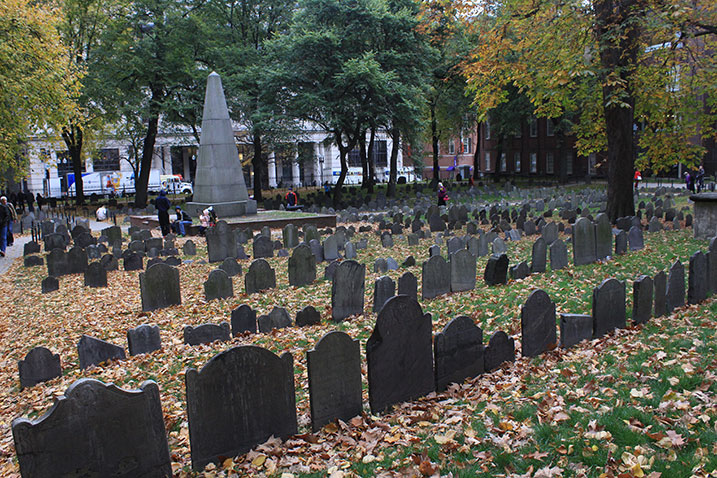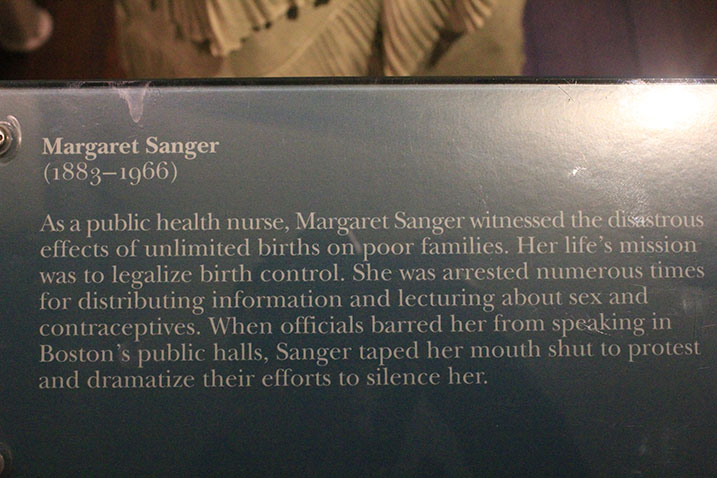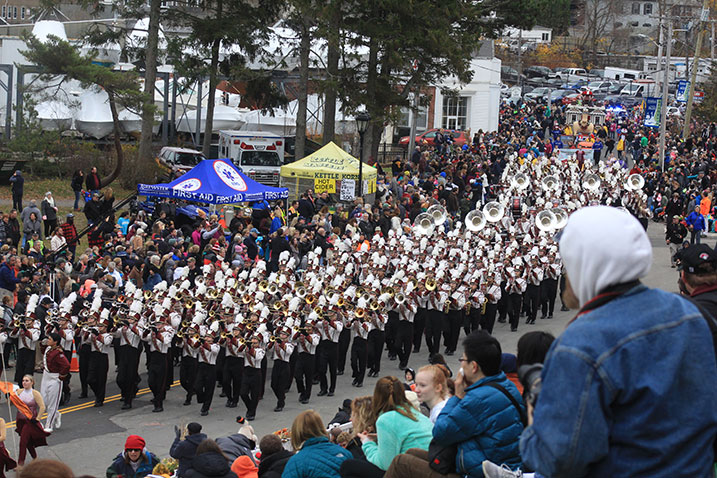Bill Potter’s Thanksgiving with the Pilgrims
Tour Recap
“The Mayflower Compact was the rough draft of the Constitution.” —John T. Adams, 2016
 n four days our tour traversed the entire period of American colonial history, especially as it related to New England and to the founding of the new nation. We visited five burial grounds, three battlefields, four museums, two churches, one historic home, a gigantic memorial and many small ones, a rock, a historic village, and most of us saw the greatest small town parade in the United States. We fought three battles, got soaked to the skin, and all the while had great fellowship, special teaching times, and ate high on the hog (or fish), including a Pilgrim banquet. We learned from lead historian Bill Potter with a supporting cast of Richard Holland, Leo Martin, and Dr. Paul Jehle, and all of it, once again, orchestrated by the maestro himself, Kevin Turley. n four days our tour traversed the entire period of American colonial history, especially as it related to New England and to the founding of the new nation. We visited five burial grounds, three battlefields, four museums, two churches, one historic home, a gigantic memorial and many small ones, a rock, a historic village, and most of us saw the greatest small town parade in the United States. We fought three battles, got soaked to the skin, and all the while had great fellowship, special teaching times, and ate high on the hog (or fish), including a Pilgrim banquet. We learned from lead historian Bill Potter with a supporting cast of Richard Holland, Leo Martin, and Dr. Paul Jehle, and all of it, once again, orchestrated by the maestro himself, Kevin Turley.

Local guide Richard Holland on Boston Common
|
|

Granary Burying Ground is full of patriots
|
On the Freedom Trail
We began the tour to Boston with a bus lecture on the Puritans — who they were, what they believed, and how they attempted to establish “A City on a Hill.” We disembarked from our coach at the monument to the 54th Massachusetts Regiment in front of the Capitol building. We gathered at the Boston Common where we talked about the role of the Common in New England history and about some of the other sites nearby like the monuments on the grounds of the Capitol (Gen. Joseph Hooker, Quaker Mary Dyer, orator and Senator Daniel Webster). As we strolled to the Granary Burial Grounds, Ritchie talked about the Park Street Church and its storied history on the Common and Bill talked about the three signers of the Declaration of Independence buried in the cemetery. We also said a few words about Benjamin Franklin’s family, James Otis, the great foe of the Writs of Assistance, and of Paul Revere, also buried in the Granary.

Hello from Old South Meeting House!
|
|

Calling evil good... get true history with Landmark!
|
We followed the red brick path of the Freedom Trail across Boston, making stops for the The King’s Chapel burial ground where we taught about John Winthrop, the greatest of colonial Massachusetts’s governors. Further hiking took us to the site of the Boston Latin School, Chipotle, Old South Meeting House (now a museum), the site of the Boston Massacre and the Old Capitol Museum. Some of us ducked into Commonwealth Books, rarely a dry hole when searching serendipitously for treasure.
We viewed Paul Revere’s house from the outside and noted the multiple skills, intrepidity, and patriotism of the man made famous by his deeds and universally admired by a poem many years after his death. We snapped our umbrella picture at his statue. We ended the first day at Old North Church and the Copp’s Hill burial ground. Our final salute took place by the graves of the Mather family. Their lives and ministries defined the colonial period up to the Great Awakening with faithful preaching, applying the Word of God to all of life including history, science, ethics, politics, and family life. They also faced the spiritual declension that accompanied the growth of the American civilization and fought against spiritual coldness and the rising shift of values that accompanied prosperity and wealth.
In the evening we met for discussion of a variety of topics with historian Bill Potter. The questions were profound and helpful.

Rain couldn’t dampen hearty spirits on the Freedom Trail!
|
|

Seafood and fellowship back in Plymouth
|
Off to War
This was battle day. We began on the bus with a review of the political and economic disruptions that preceded the War for Independence. Disembarking on Lexington Green, we drew up our line of battle where the patriots stood on the day the world heard a shot from an unknown assailant. We told of Captain Parker and his thin line of Minutemen facing the Royal Marines and Captain Pitcairn. The Lexington Common, usually the scene of grazing cattle and marketers, political speeches and children playing, in a moment became a place that changed the course of history. We formed our battle lines and charged in commemoration. We remounted our trusty coach and trundled off to Concord Bridge and a picnic lunch. We gathered around the minuteman statue and tried to picture the scene as the British Light Infantry faced off against the local militias and were bested quickly. The long bloody fight back to Boston insured that the war would be fierce and without compromise. We walked the fields and the path taken by the very men who fought and died in defense of their homes.

“Here once embattled farmers stood” on the Concord Bridge
|
|

Back in time on Bunker Hill
|
To Breed’s Hill we drove and once again armed, re-fought the “Battle of Bunker Hill.” British casualties were severe, General Joseph Warren and Captain Pitcairn both died there and the battle became a byword among those whose devotion to independence would be put to the test for the next eight years. Some of our most energetic folk walked to the top of the monument, a testament to their youth, if not their enthusiasm for the cause. Our final stop for the day took place at the Maritime Museum associated with the USS Constitution. Although a hands-on and informative place, we had to make do with seeing the battle ship from a short distance while it resides in dry dock. She still looked formidable, and is an active naval vessel — the oldest one of any navy in the world.
Plymouth Walking Tour
We walked the streets and fields of Plymouth on this day. We began at the National Monument to the Forefathers, a magnificent statue with thirty-six-foot-tall Faith on the pedestal above four seated representations of Morality, Education, Law and Liberty. Dr. Paul Jehle related the story of Hammatt Billings and the history of the monument’s creation. He and local guide Leo Martin then gave us a profound and inspiring explanation of the symbols that adorn the monument, as related to the four seated “principles upon which the Pilgrim Fathers proposed to found the Commonwealth.”

Dr. Paul Jehle and Leo Martin at Forefathers Monument
|
|

Reading the roll of the dead from the first winter on Cole’s Hill, Plymouth
|
We walked to the Pilgrim Mothers Monument where we reflected on the terrible sacrifices the women of the Mayflower, and of the church in Leyden made in order to found the colony and raise families in harsh and unforgiving conditions. Many of them died the first winter. The Pilgrim mothers’ devotion, piety and perseverance was paramount to the expedition’s success in planting a Christian civilization. We gazed on Plymouth Rock as Leo explained its significance. Our pause at the Bradford Monument reminded us of God’s Providential provision of good leadership, without which the enterprise would have foundered. We discussed the providence of God on every hand, even to the Chief of the Wampanoags, Massasoit, with whom the Pilgrims found favor and made a treaty that lasted fifty years.
We looked on the Mausoleum on the top of Cole’s Hill that holds the bones of the Pilgrims who died that first winter — a stirring memorial to the cost of following their call to the New World. We ate lunch at the historic site of the first Pilgrim shelter, now 33 Leyden Street. We were greeted by Beth Perera, whose husband Jerry leads the Leyden Preservation, a group of Christian men devoted to the preservation of the truth regarding the Pilgrims and the values they exemplified.
We walked by the Jenny Grist Mill as Leo again related the importance of the site and of its preservation. We then climbed the steep hill to Burial Hill, the site of the first fort and meeting house and the final resting place of most of the Leyden congregation that made it to America. We ended the day at the Pilgrim Hall Museum where we were warmly greeted by the new curator and given the run of the place till we were satisfied. The magnificent paintings, artifacts, and library are a testament to the folks who have sought to preserve the memory and soul of the Pilgrim colony.

Conversing with the locals at Plimoth Plantation
|
|

A Pilgrim feast for a Farewell banquet!
|
Plimoth Plantation
The morning of our final day provided opportunity to return to sites of the previous day, sleep in, or shop around Plymouth. Some of us returned to Burial Hill where we revisited the Warren grave, Adoniram Judson and William Bradford. After lunch everyone made their way to Plimoth Plantation and the living history portrayed there by professional actors in “first person.” We spoke with most of the costumed interpreters, always an entertaining prospect. We ended our tour with a fine 1623 period banquet attended by Miles Standish and the Mrs., both very engaging personalities. We conducted our traditional quiz about things learned on the tour, with fine prizes as a reward. As is our custom, we gave opportunity for Bill Potter to summarize the tour; he spoke of the bedrock nature of the Pilgrim and Puritan colonies, established for the Glory of God and the implementation of His Law. Testimonials by the attendees concluded the evening, with all attesting to the importance of the fellowship of travelers of like faith and giving thanksgiving to God for the opportunity to do so.

Enjoying a bountiful harvest!
|
|

America’s Hometown Parade, Plymouth, Massachusetts
|
When we note the wonderful providences of God, we see many in the founding of our Republic. From the freezing and wind-swept shores of New England came a people whose God was the Lord and whose descendants number in the millions. Noting the spiritual declension that began even as the second generation succeeded in farming and business, we view a steady erosion of the Reformation doctrines and practices that so animated the Founders. God has arrested that decline from time to time with awakenings of true repentance and faith in our nation. We pray for faithful Gospel preaching and those showers of blessing once again, as we reflect on our beginnings in Plymouth, Boston, and across the English colonies in the New World.
Bill Potter
Landmark Events
2016

Check the Landmark Events blog for more pictures from the tour!

|







